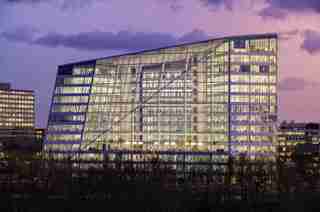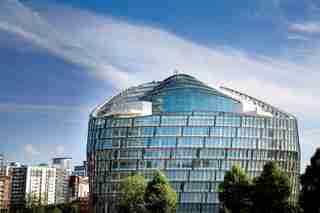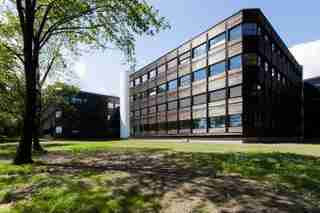September 13,2022
Tour Beautiful Eco-Friendly Offices Around the World
by David Stewart

With their massive sizes, office buildings are, unsurprisingly, not the greenest of structures. But architects and engineers are changing that notion, using the latest technology to increase buildings’ sustainability. Here, we select eight of the foremost eco-friendly offices around the world.
Shown: The Edge, Amsterdam Developed by OVG Real Estate, Deloitte’s Amsterdam headquarters, called the Edge, received the highest recorded BREEAM score ever—98.36%—and is the first building to employ Philips’ Ethernet-powered LED-connected lighting. This innovative technology allows employees to regulate their workspace lighting and climate with a smartphone app, and helps lower energy costs by recording data on carbon-dioxide, temperature, and humidity levels. PLP Architecture designed this energy-neutral building, which has over 4,000 square meters of solar panels and a 15-story atrium that provides natural light. Additionally, all of the power needed for heating and cooling comes from underground-aquifer thermal energy.

One Angel Square, Manchester, U.K.
One Angel Square, the Manchester headquarters for the Co-operative Group, is one of the largest buildings in Europe to have an outstanding BREEAM rating (a method to measure sustainability). The building, which is energy positive, generates power from rapeseed oil grown on the company’s farmland, with the climate controlled by vents on the façade that open and close. Architectural firm 3DReid modeled One Angel Square after a beehive, and included a central atrium that maximizes the spread of natural light, reducing the need for artificial lighting.

Powerhouse Kjørbo, Oslo
Powerhouse Kjørbo is the first energy-positive office (meaning it generates more power than it uses) to be created thro ugh renovation. Norwegian architecture firm Snøhetta turned two buildings from the 1980s into one of the most sustainable structures in the world while keeping many of the original designs. The original dark exteriors were replicated using charred wood, a material that minimizes maintenance costs and provides insulation. Ground wells in the surrounding park heat and cool the structure, and sensors control the energy and climate systems.
7 More London, London
Expanding upon its One Embankment Square headquarters, which underwent a two-year refurbishment to transform a tired building into one of the most sustainable offices in the world, Pricewaterhouse Cooper opened a new space at 7 More London in 2011. The building was the first major office in the U.K. to achieve a BREEAM “Outstanding” rating. Working with Foster + Partners as well as architects and engineers from the Building Design Partnership, PWC created an office that will generate 25 percent of its energy on site through features like a power system fueled by solar panels and recycled cooking oil. The site also offers bicycle parking to encourage employees to use eco-friendly transportation.
The Tower at PNC Plaza, Pittsburgh, Pennsylvania
The 33-story Tower at PNC Plaza was designed by Gensler to be the world’s greenest skyscraper. It features a double-skin façade with windows that open to let in fresh air and allow the building to breathe; a catwalk between the outer and inner walls allows employees to get fresh air without going outside. This system is expected to naturally ventilate the tower 42 percent of the year.
Bank of America Tower, New York
Located in Manhattan and designed by Cookfox Architects, the first high-rise office building in the U.S. to receive a platinum LEED rating is occupied by the Bank of America. The tower is made out of blast furnace slag, a recycled material, which cut cement usage by 45 percent and reduced pollution during construction. The faceted crystalline design not only allows more natural light to enter the offices, but enhances views and minimizes the building’s impact in the surrounding area.
The Crystal, London
Designed by WilkinsonEyre as a sustainable-city initiative for Siemens in London, the Crystal is an all-electric building that hosts the world’s largest exhibition on the future of cities. The façade, modeled after the geometric shape of a crystal, uses high-performance solar glass that allows in about 70 percent of natural light but only 30 percent of solar energy, keeping the interior bright and cool. The Crystal generates all of its own energy through solar power and a ground-source heat pump, and in turn has no heating bill.
Shanghai Tower, Shanghai
At 2,073 feet, the Gensler-designed Shanghai Tower is the tallest building in China and the second tallest in the world. Its asymmetrical form is designed to withstand Shanghai’s typhoon-force winds, and almost 300 wind turbines power the exterior lighting. The Shanghai Tower is considered a city within a city, with nine vertical zones (ranging from 12 to 15 stories each) that contain sky gardens, public space, shops, and restaurants. A double façade provides insulation and saves energy, and one-third of the site consists of green space and extensive landscaping, which cool the grounds.
BMW Welt, Munich, Germany
BMW Welt, designed by Coop Himmelb[l]au in Munich, functions as a distribution center, event forum, and office for the car company. The roof, which is large enough to cover Venice’s Piazza San Marco, was designed to look like a floating cloud and helps heat the building with photovoltaic solar panels. The conference hall is naturally ventilated by thermal currents and wind pressure, and abundant outdoor vegetation helps keep dust out of the ventilation system.






